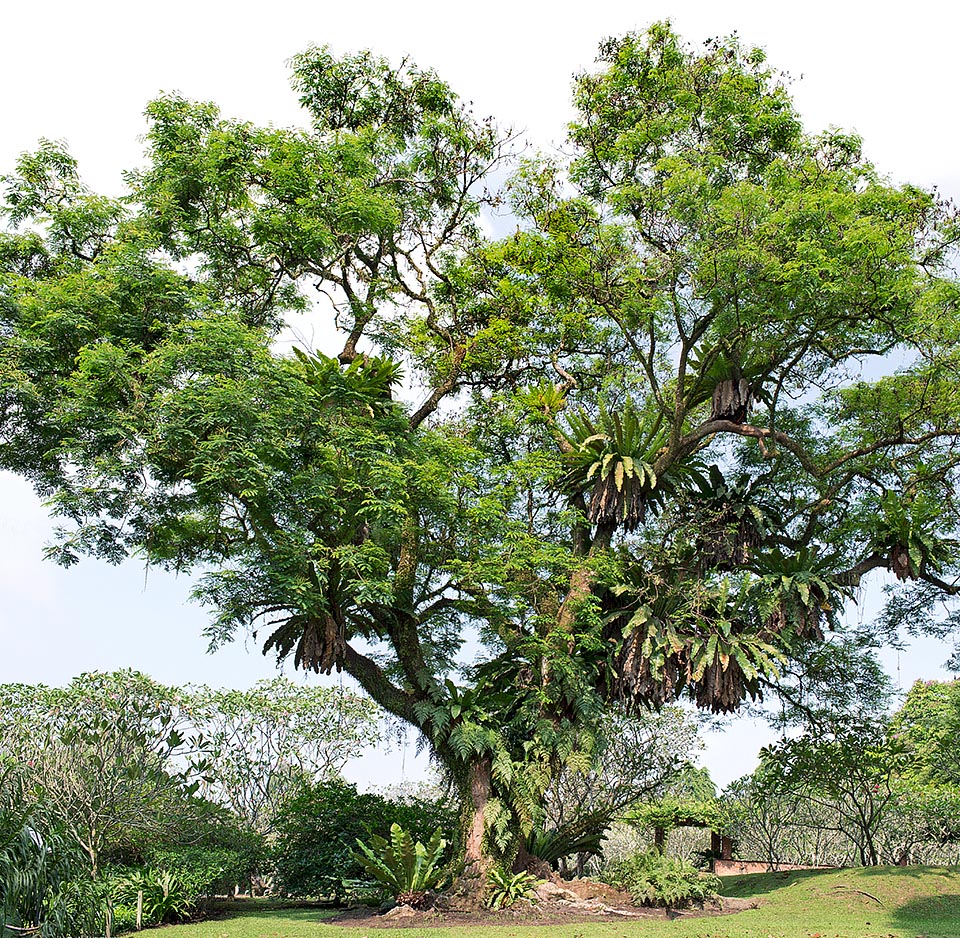Family : Fabaceae

Text © Pietro Puccio

English translation by Mario Beltramini
The species is native to Australia (Northern Territory and Queensland), Bangladesh, Cambodia, China, India, Indonesia, Laos, Malaysia, Myanmar, Papua New Guinea, Solomon Islands, Sri Lanka and Vietnam, where it grows in the forests characterized by humid or monsoonal tropical climate.
The name of the genus is the combination of the Greek terms “aden” = gland and “anthera” = anther, from “anthos” = flower, with reference to the small glands on the anthers; the name of the species comes from the Latin “pavo, -onis” = peacock, therefore, similar to a peacock.
Common names: acacia coral, beadtree, circassian-tree, coral-wood, false jequirity, false red-sandalwood, red beadtree, red beantree, red sandalwood tree, red sandalwood, saga tree, sandal beadtree, sandalwood tree, zumbic tree (English); hai hong dou (Chinese); bois de condori, corail végétal (French); carolina, contas-de-rosario, pau tento (Portuguese); árbol del coral, coralillo, coralito, peronia, peronias chata (Spanish); Condoribaum, Indischer Korallenbaum (German).
The Adenanthera pavonina L. (1753) is a deciduous tree up to about 15 m tall with wide canopy and trunk up to about 45 cm of diameter with greyish to dark brown bark, smooth, slightly fissuring with the age. The leaves are alternate, bipinnate, 30-50 cm long, with 2-6 pairs of opposite pinnae, 7-12 cm long, carrying 5-15 couples of sessile leaflets, alternate, oblong-ovate, 1,5-4,5 cm long and 0,5-2,5 cm broad, of pale green colour.
Racemose axillar and terminal inflorescences, 8-20 cm long, carrying tiny flowers slightly perfumed of cream white or pale yellow colour, tending to orange, with campanulate calyx with 5 teeth and 5 oblong petals about 0,3 cm long, united at the base, and 10 stamina with anthers provided with a tiny deciduous gland at the apex. The fruits are dehiscent curved legumes of dark brown colour, 10-22 cm long and 1-2 cm broad, which open when ripe in two twisted valves which remain for long time on the plant, containing 8-12 lenticular seeds of 0,7-0,9 cm of diameter, hard, of scarlet red to brick red colour, glossy, dispersed by the birds.

Native to South East Asia and Australia, where can be 15 m tall, Adenanthera pavonina is cultivated in the tropical gardens due to the very expanded showy foliage © Giuseppe Mazza
Species of fast growth and easy cultivation suitable for tropical and humid or seasonal subtropical climates and marginally warm temperate, where it can stand sporadic, and for very short time, temperature drops around to 0 °C. It requires full sun and can grow in a wide variety of soils, preferably neutral or slightly acidic, well drained, which it enriches, being capable, like other leguminous plants, to fix the atmospheric nitrogen.
It is utilized as road tree, due to its ornamental foliage, as well as shade tree in the plantations of cocoa, coffee and other crops. The hard, compact and long-lasting wood, is often utilized as a substitute of the red sanders (Pterocarpus santalinus) one for valuable furniture, floors, boats, in the constructions and for various handicraft products, besides as fuel and the red colour obtained from it was in the past used as colouring of textiles and in the cosmetics; the bark, containing saponins, was used as detergent.
The seeds are utilized for necklaces, bracelets, rosaries and other ornaments; in some zones, due to the high contents of proteins, they are consumed grilled (they are toxic when raw) with the rice and the young leaves as vegetable. The seeds due to their uniformity of weight, about 0,25 g each, in the past were utilized as reference in the trade of gemstones, gold and silver. The oil gotten from the seeds contains appreciable quantities, about the 20%, of lignoceric acid, rarely present in those of other species.
Various parts of the plant are used in the traditional medicine for various pathologies; studies on animals have shown antibacterial, anti-inflammatory, antihypertensive properties of the seeds extracts, which present also insecticidal properties.
Synonyms: Corallaria parvifolia Rumph. (1743); Adenanthera polita Miq. (1855); Adenanthera gersenii Scheff. (1869).
→ To appreciate the biodiversity within the family of FABACEAE please click here.
